Welcome to
Young's Photo Gallery
James W. Young, Professional Photographer
Photographic History of Table Mountain
Observatory

Part 4: Smithsonian Exits - NASA/JPL begins Optical and
Radio Astronomy Research - Solar Studies Continue
By James W. Young
retired astronomer from Table Mountain Observatory
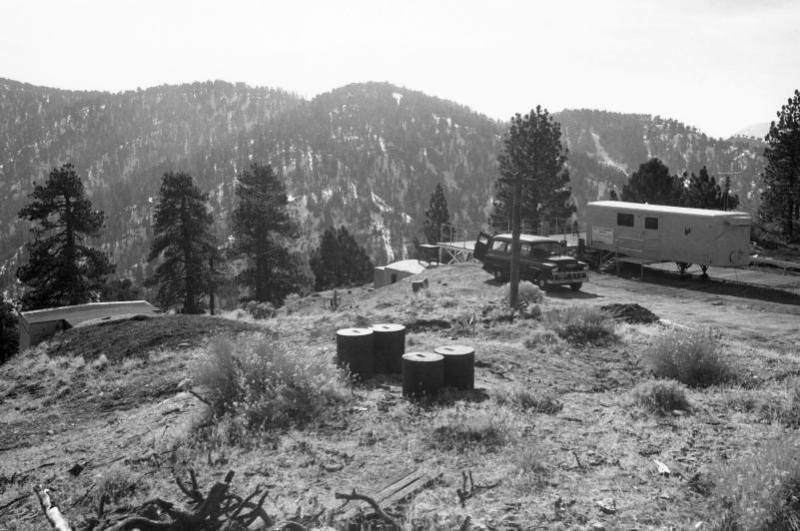
A very interesting transition image! As JPL pondered acquiring this site for a permanent
testing facility for solar cells and panels, an immediate interest developed to begin some
sort of optical astronomy program. Ray Newburn, in the JPL Space Science Division, had
been looking for a site to place an optical telescope for planetary astronomy studies, and
surveyed for a possible site at Mount Wilson. However, the close proximity to the lights
from Los Angeles to Mount Wilson was not acceptable. With the ongoing JPL solar cell/
panel testing in progress at Table Mountain, this already developed site, with all utilities
installed, seemed like the perfect place! Newburn also had recently acquired a 16-inch
'Nishimura' cassegrain telescope from Biela Observatories in Anaheim, CA for his needs.
Ironically, the above image shows that current testing facility in the background, while in
the forground are the four pier supports for Edson's 1940-41 20-inch telescope building
for his Mars opposition observations. This exact spot was selected for JPL's new optical
astronomy telescope Newburn had already purchased!
The Nishimura telescope delivered to Newburn in 1961
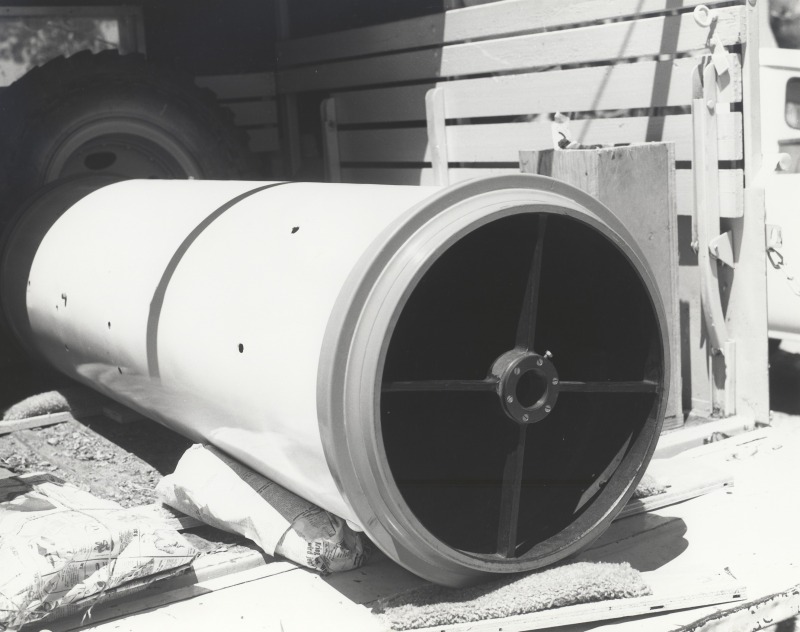
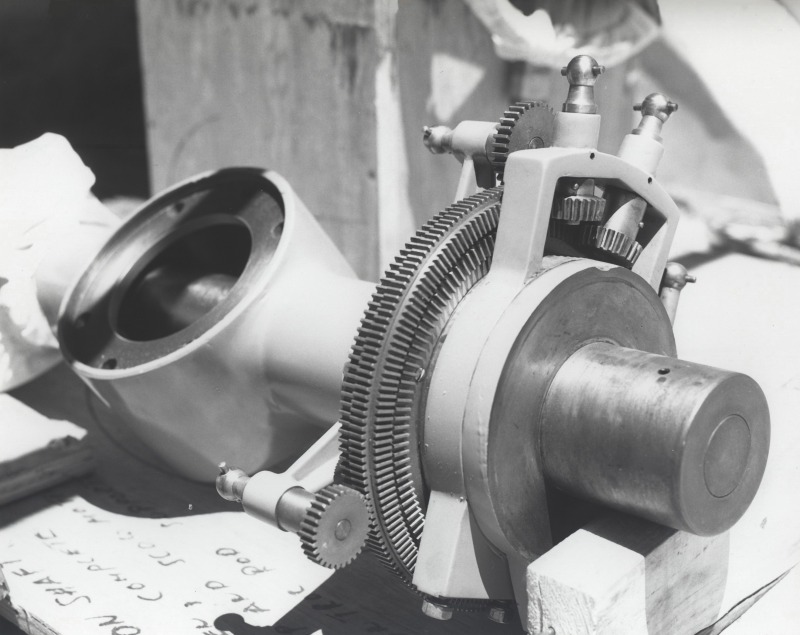
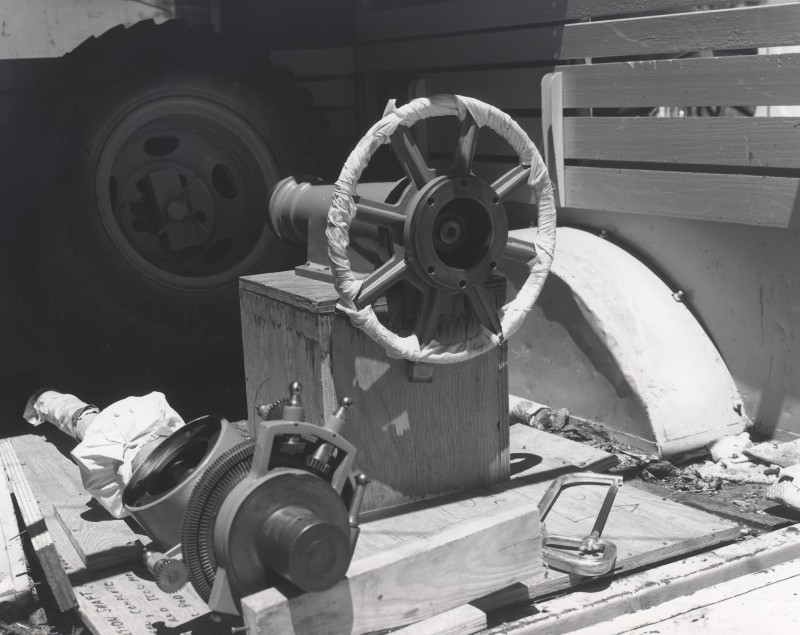
The parts and pieces of the 16-inch telescope yet to be assembled
Newburn then looked for a well qualified experienced site astronomer/supervisor to watch
the building, dome installation, telescope assembly/installation, and then ultimately begin a
synopyic planetary patrol of Venus, Mars, Jupiter, and Saturn. He found such a man at
the New Mexico State University's campus in Las Cruces, New Mexico; Charles F. Capen.
Capen's qualifications included work at Lowell Observatory, a field director at the Shiraz,
IRAN Smithsonian Baker-Nunn tracking station in the late 1950s, and finally on staff at
New Mexico State University. Capen accepted Newburn's offer in the Spring of 1962.
Since Smithsonian Institute was leaving Table Mountain, JPL first needed to obtain a new
USFS permit to officially occupy and develop the site for its own use.
1962 USFS 'TERM SPECIAL USE PERMIT'
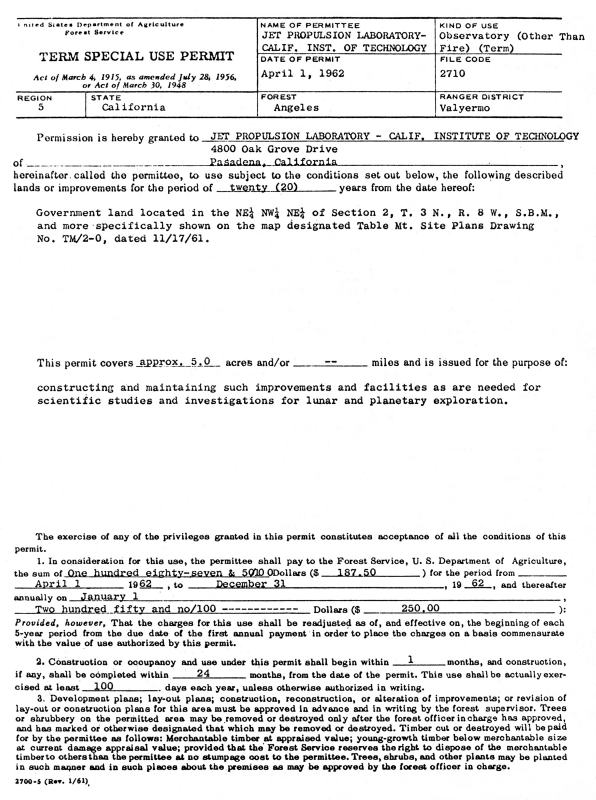
Annual use permit for JPL cost $250.
Smithsonian needed some sort of legal compensation for their buildings, furnishings, and
equipment remaining on the site from JPL.
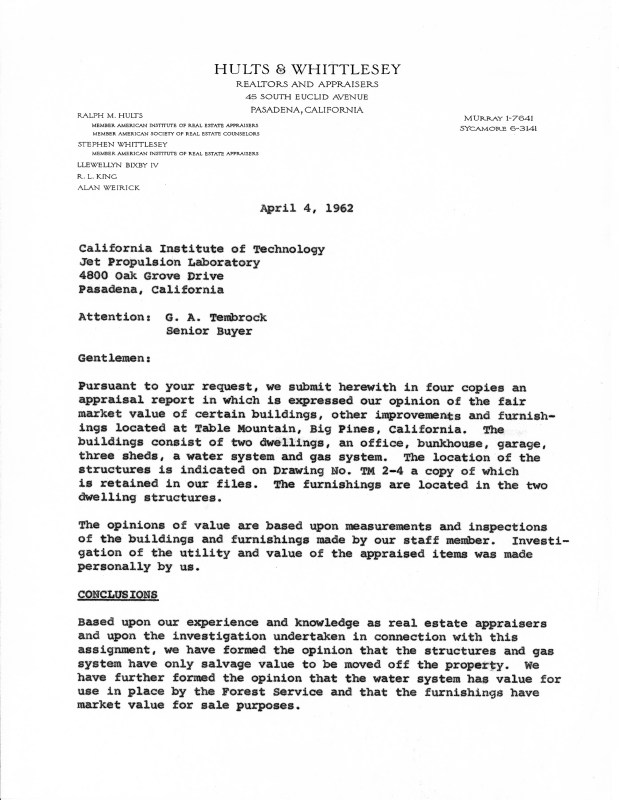
This is only page 1 of this companies appraisal document. Their findings concluded that only
two of the old Smithsonian buildings had any furnishings of value, therefore JPL offered, and
ultimately paid $12.000 to Smithsonian for that compensation.
With Charles Capen on site, a new building for the 16-inch telescope began in June, 1962
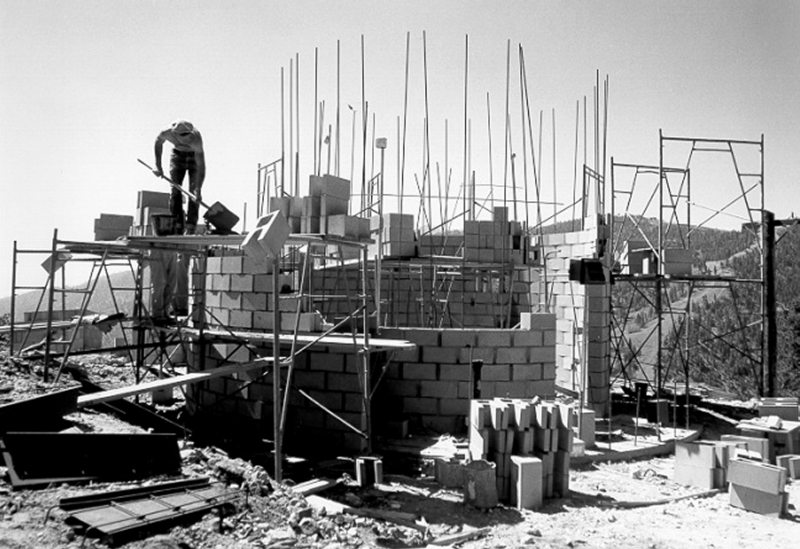
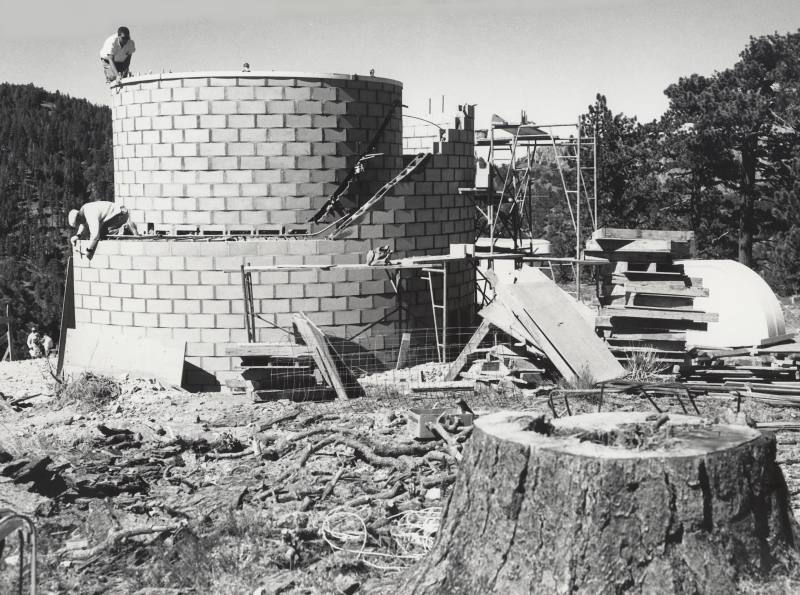
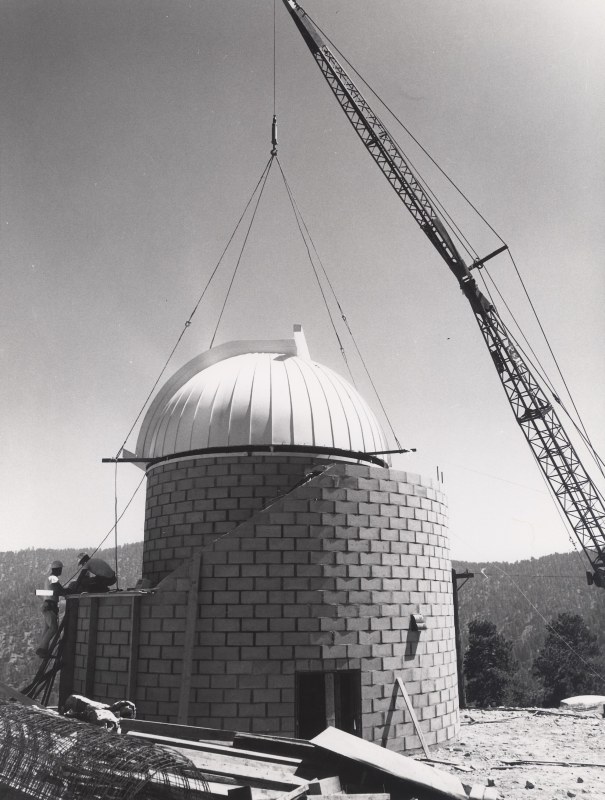
Building construction, and the installation of a 16-foot Observa-DOME
The telescope was assmebled at Table Mountain under the direction of both Newburn and Capen, then
installed into the new building
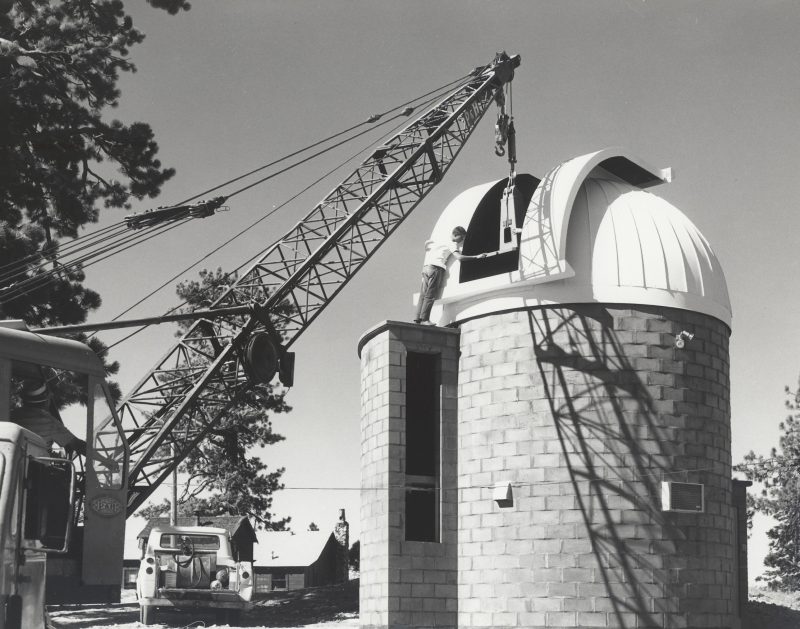
Charles 'Chick' Capen checking out the new clock drive mechanism
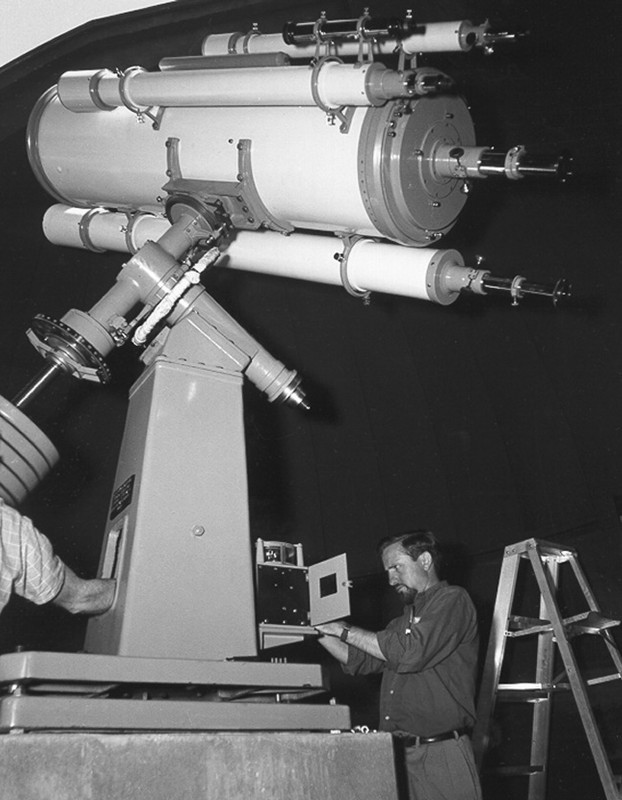
The mechanical weight-driven clock drive
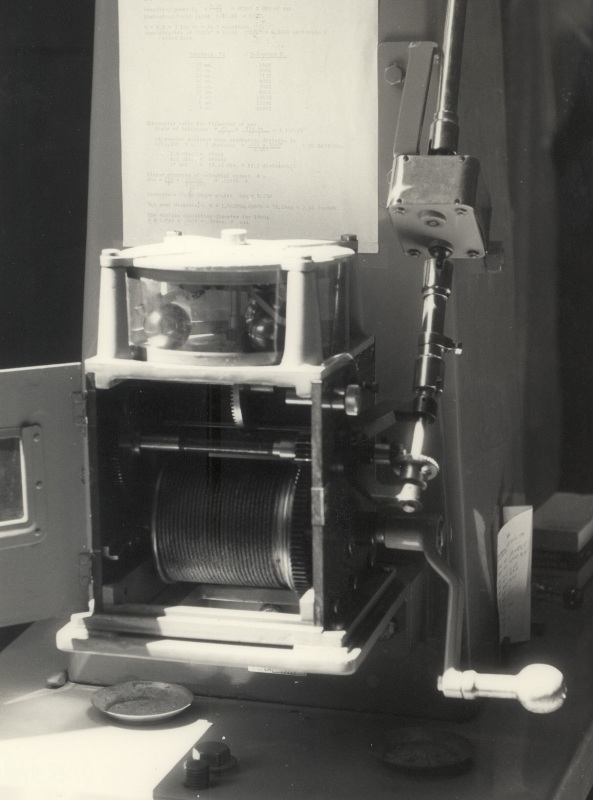
The new telescope was ready for its initial operations on August 1, which is known as
'First Light' (the very first use of any newly installed telescope; either visually or by
photography/photometry). Newburn and Capen discussed hiring an assistant observer
and darkroom technician.
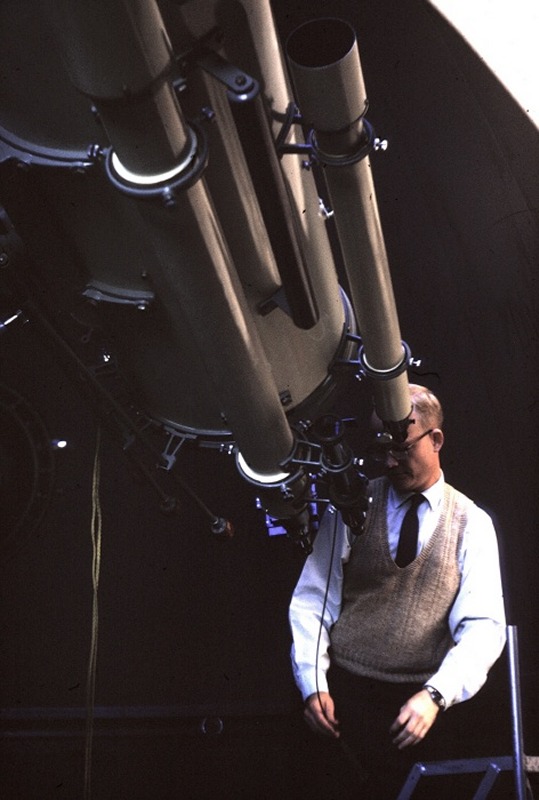
Ray Newburn - 1962
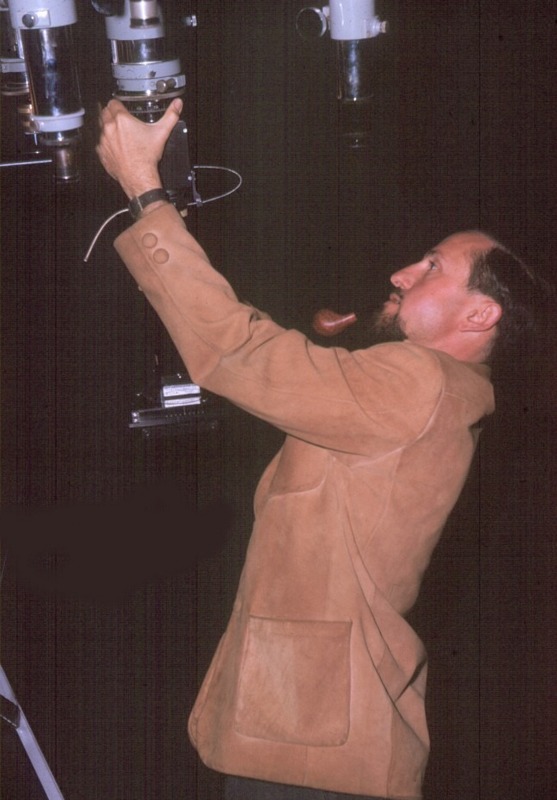
Charles 'Chick' Capen - 1962
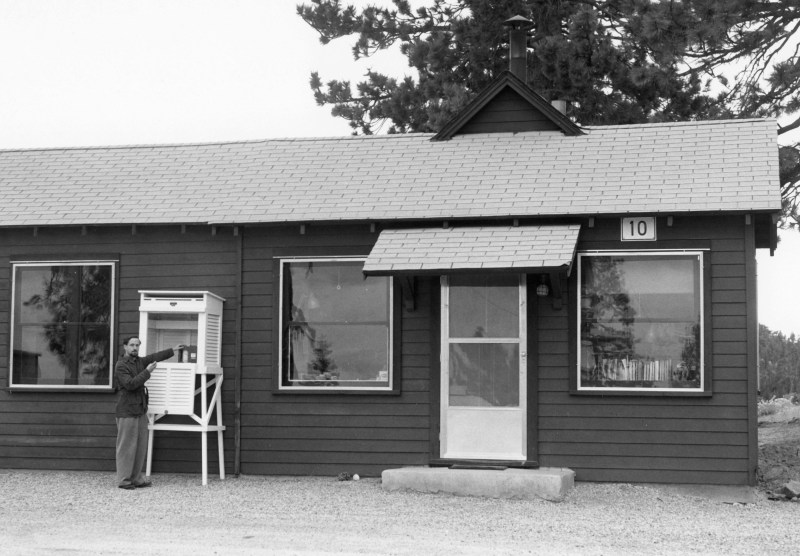
Charles 'Chick' Capen standing in front of the Observatory's Office, TM-10, late 1962
At this same time, the author was working at the NASA Exhibit of the 1962 Seattle
World's Fair where several NASA technical people from various NASA facilities around
the country spent a few weeks assisting in the exhibit's day-to-day operations. Their
job was talk to the public, and train all the young guides which I was one...in this case
the 'Lead Technical Guide'. One of these visiting NASA technical representatives was
from JPL; Thomas Bickler. Telling me JPL had just finished building a new observatory,
he suggested I should apply for a position there becasue he already knew of my intense
interest in astronomy. I did so, and one week after the Fair closed, JPL flew me down
to Pasadena for an job interview. I was hired and started work on November 12, 1962.
I joined Chick, and the site's caretaker, Jack Lyon, after I moved down to Wrightwood
from Seattle.
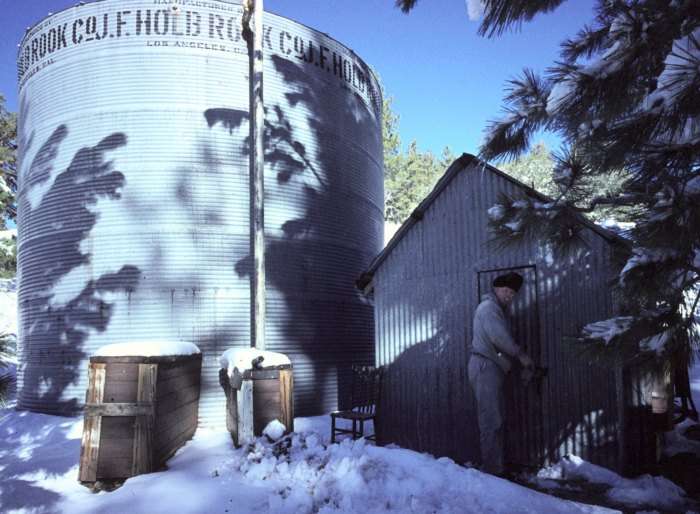
Jack Lyon at the water pump station and storage tank - 1962
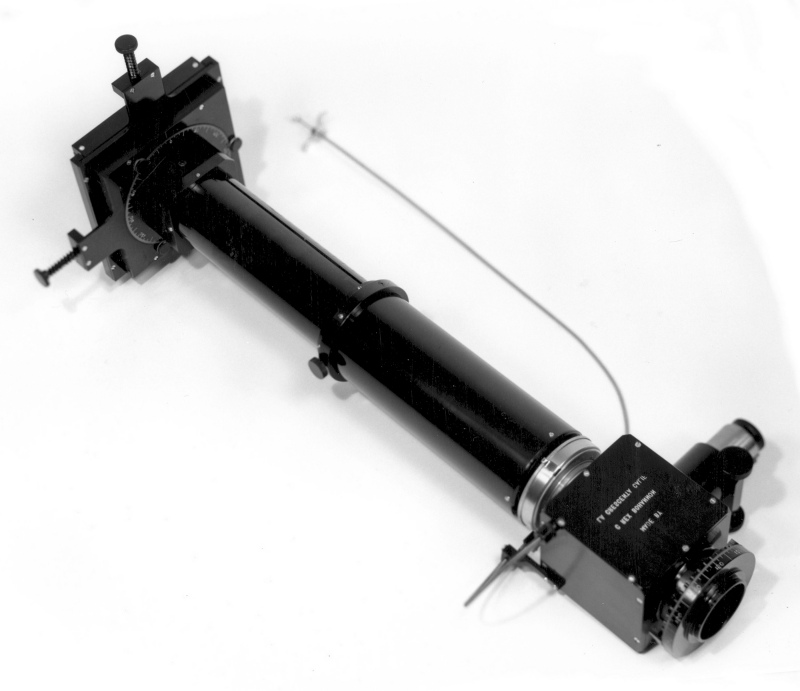
A specialty 3 1/4 x 4 1/4 glass plate camera made for the planetary synoptic patrol images
by Rex Bohannon of Pasadena, CA - 1962
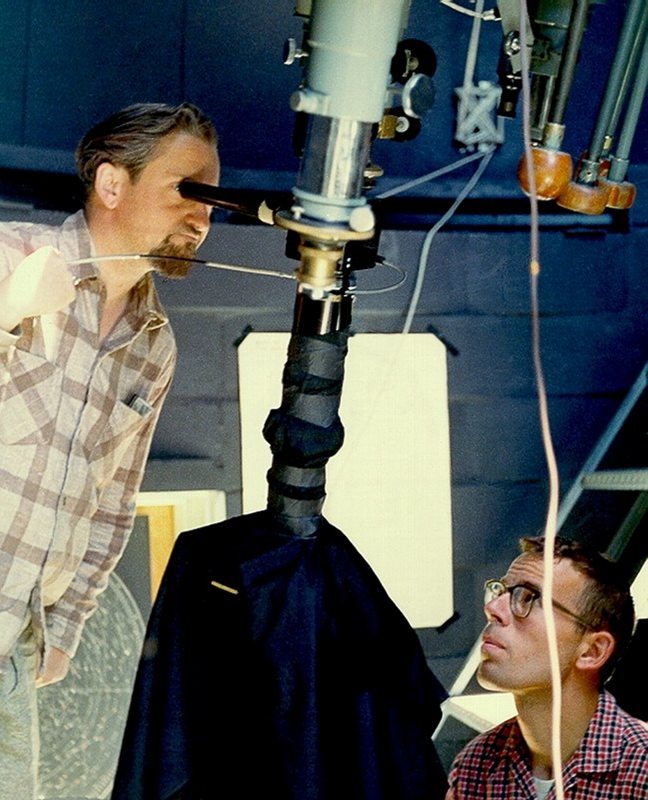
Chick teaching his new observer assistant, Jim Young - 1962
The new 16-inch telescope building fully operational in the fall of 1962. The JPL solar cell
and panel testing area is to the west next to the newer of the two Smithsonian bunkers.
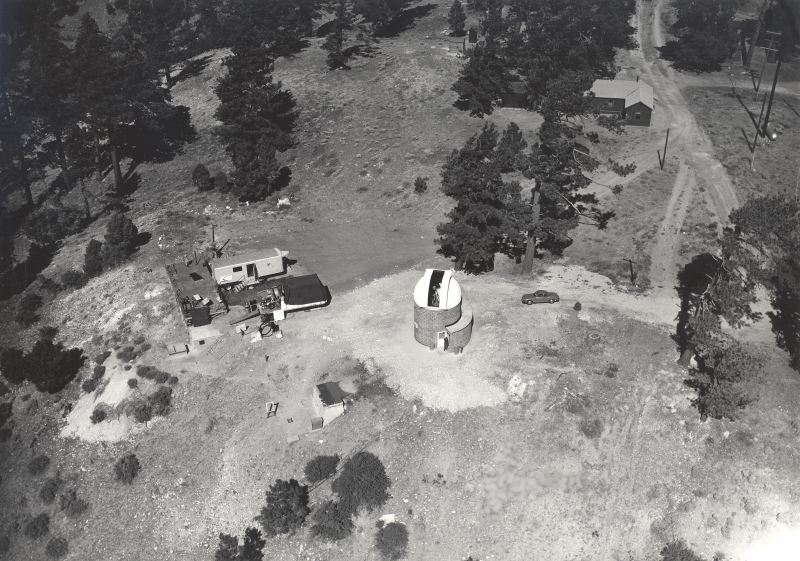
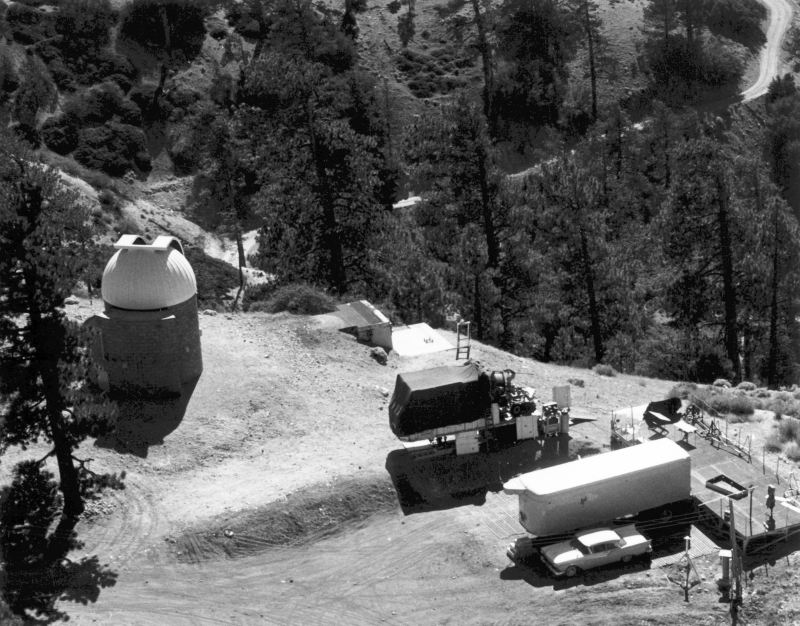
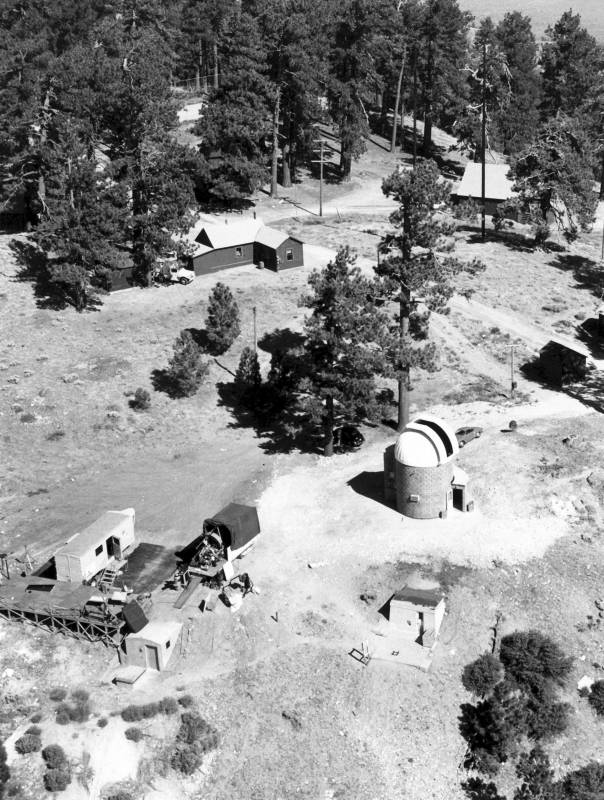
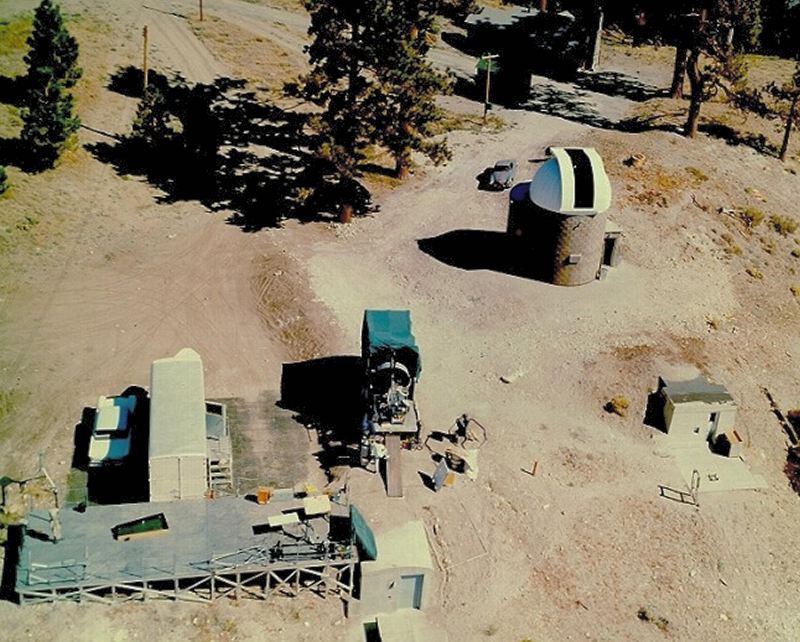
The solar testing area (the Mobile Solar Measurements Laboratory) next to the second old
Smithsonian bunker (at the lower center edge) - 1962
It is interesting to note here that the same Tom Bickler who the author met at the Seattle
World's Fair, sent a series of pictures showing Bickler's involvement with JPL's solor work
being done at Table Mountain, along with the Hughes, EOS, Spectrolab, and Hoffman. He
provided the author with a series of pictures showing these other companies testing various
pieces of their own equipment around JPL's Mobile Solar Measurements Laboratory.
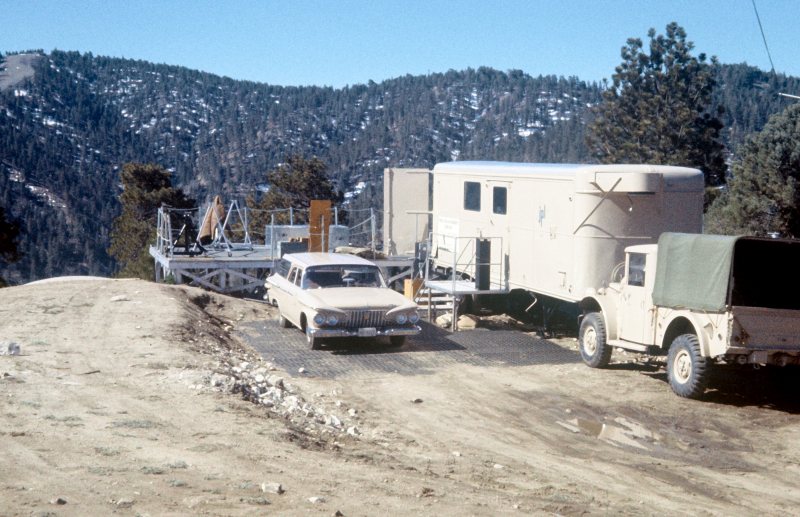
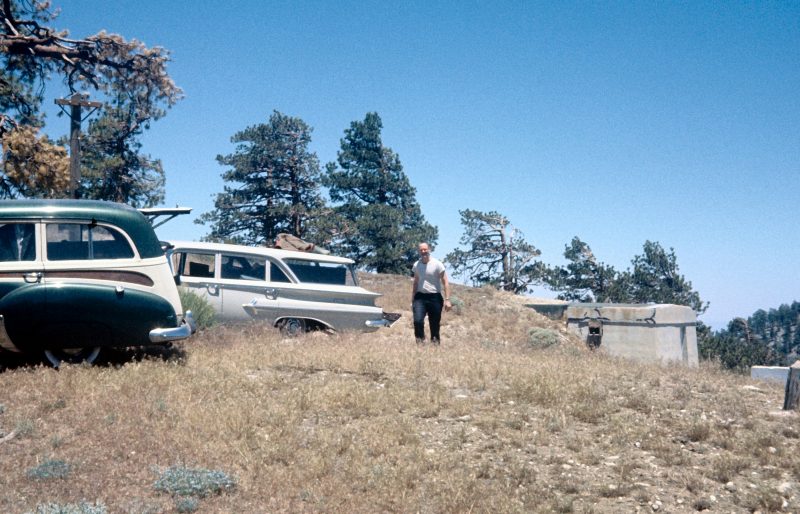
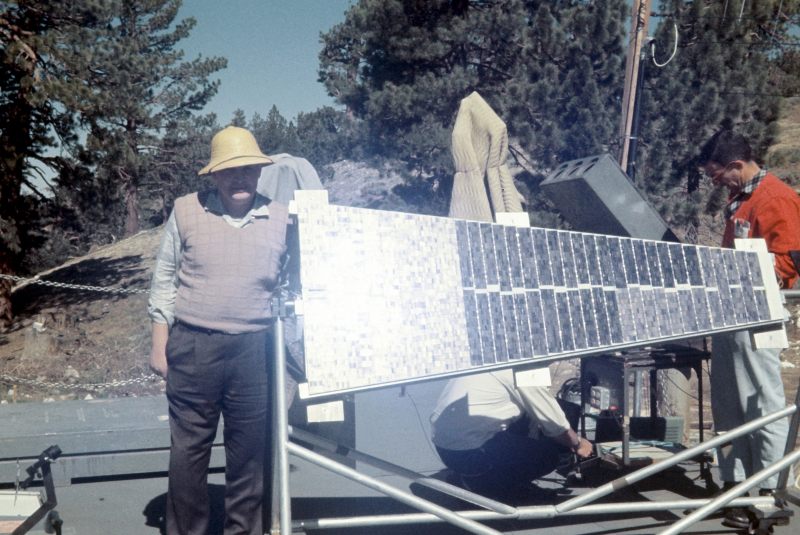
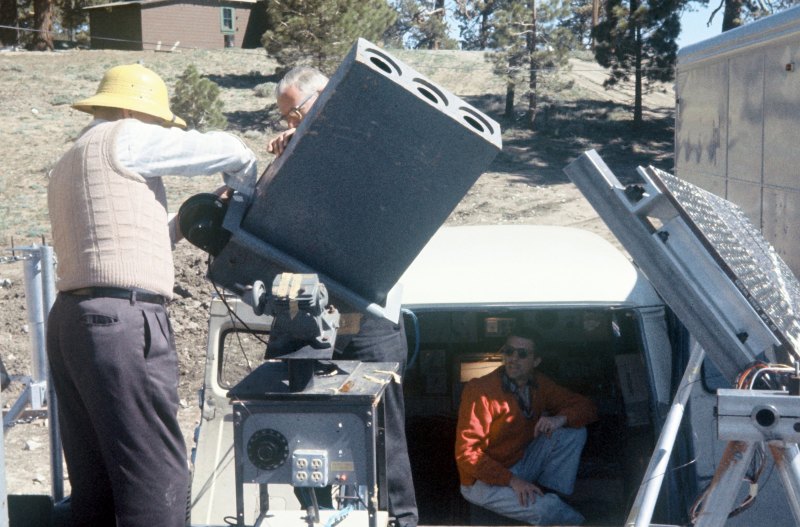
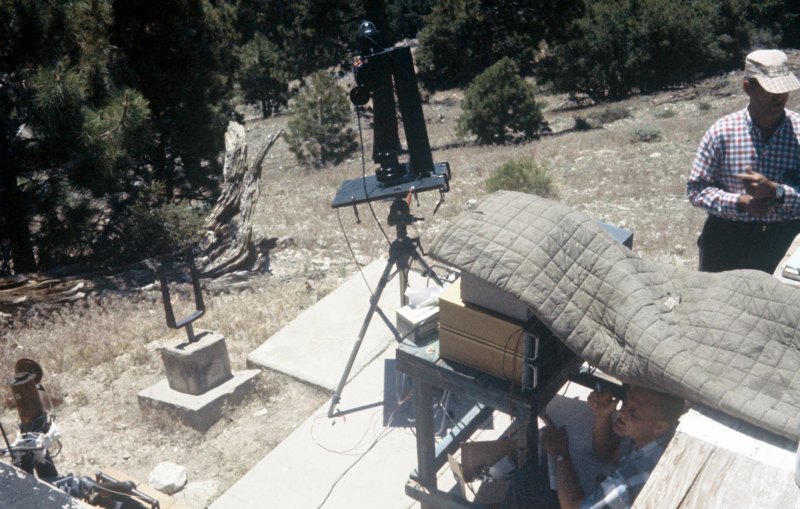
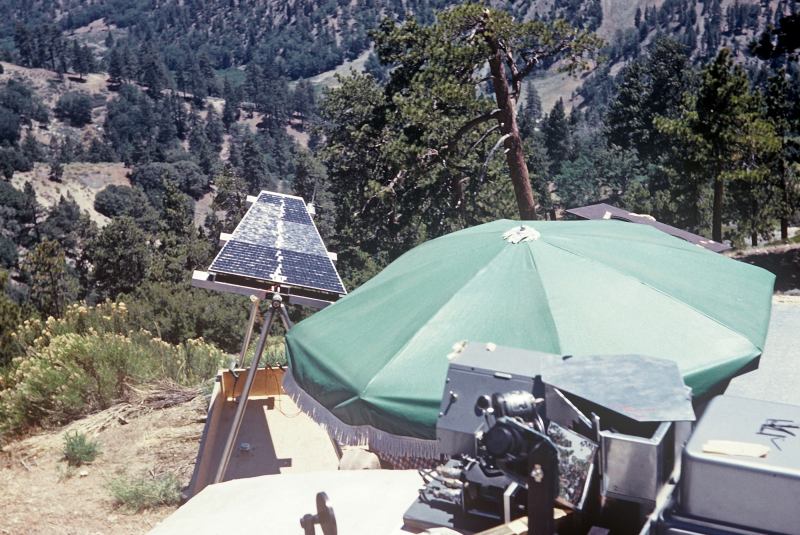
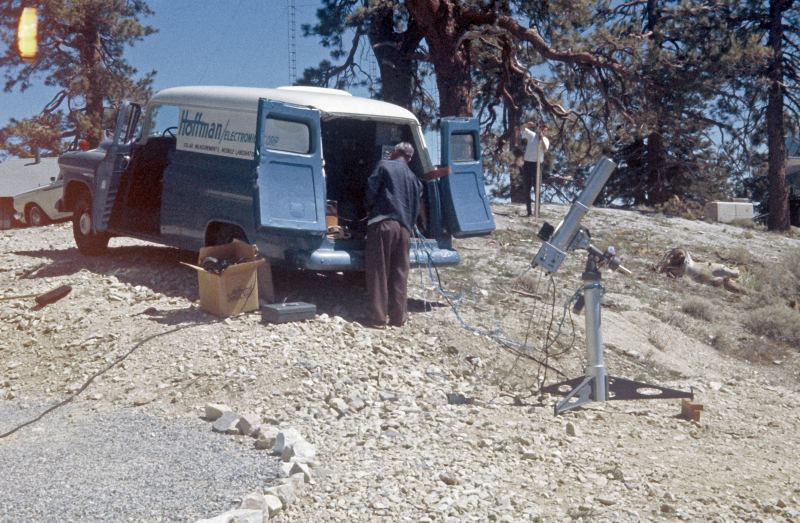
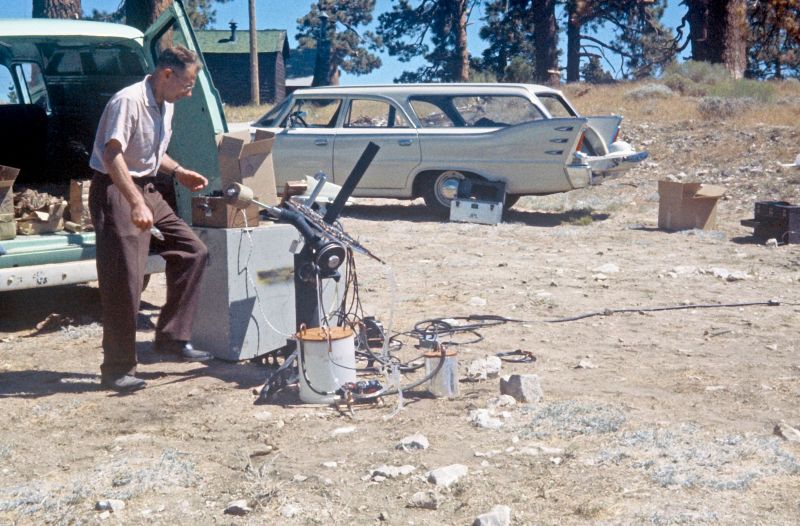
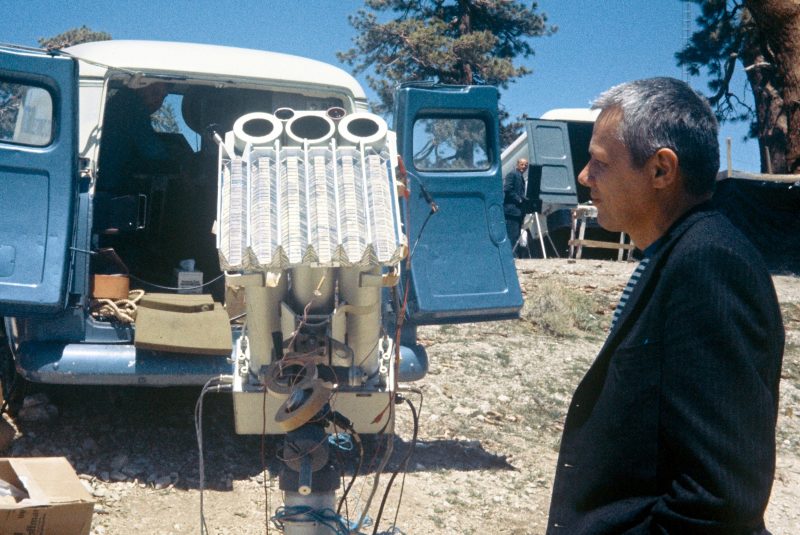
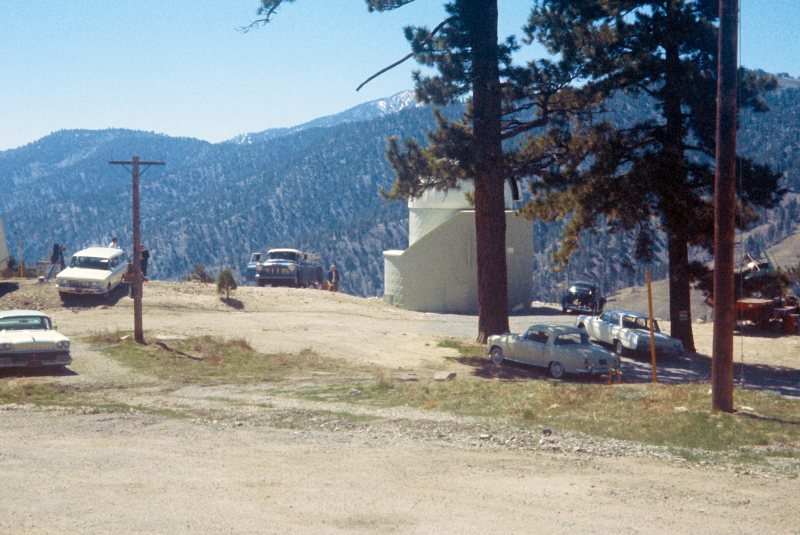
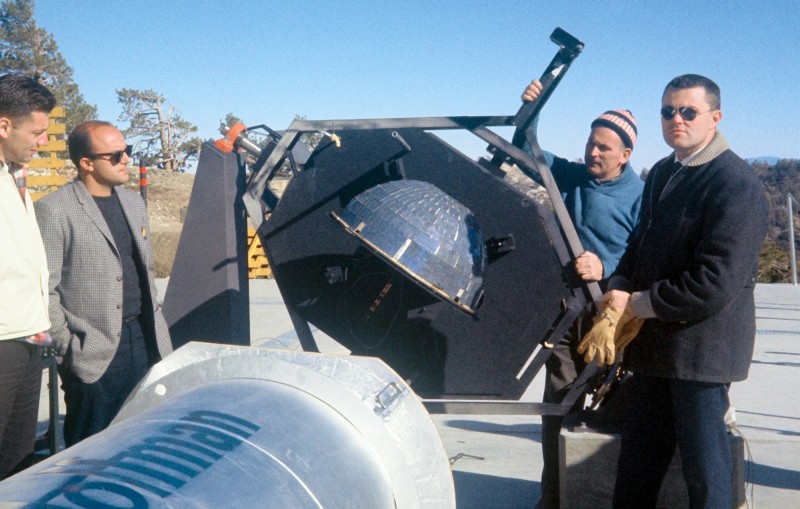
These images show the various company's equipment and personnel that used Table Mountain
to test their own solar cell development between 1961 and 1963.
In 1964, and after JPL negotiations with the USFS, a 1 1/2 million gallon water previously
used tank, was brought to Table Mountain, and constructed near the entrance to the facilty.
This tank replaced the old aging pimping station and low pressure gravity-fed water system
Smithsonian installed back in the late 1920s. This new tank also served as an entire water
service system for the needs of the local campgrounds, ski resort facilities, and all other
local (mountain) organizational camps for youth groups.
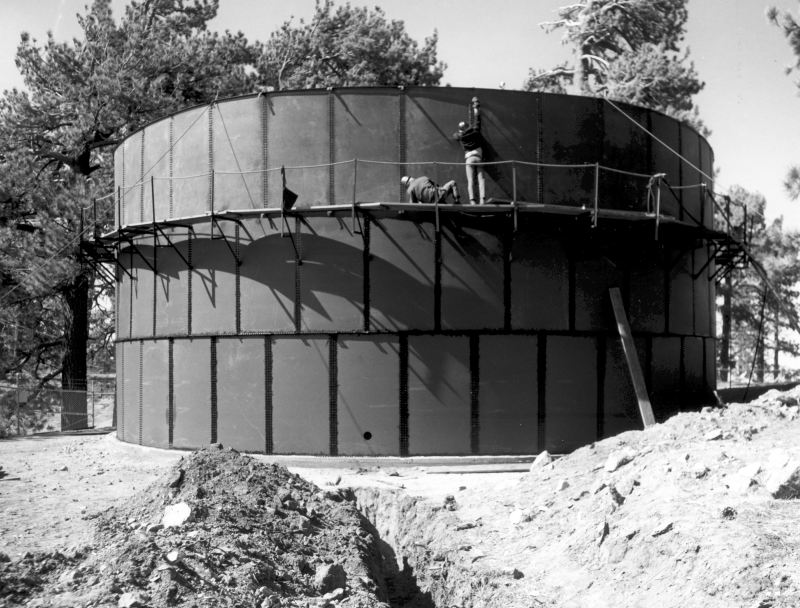
Water tank construction in 1964
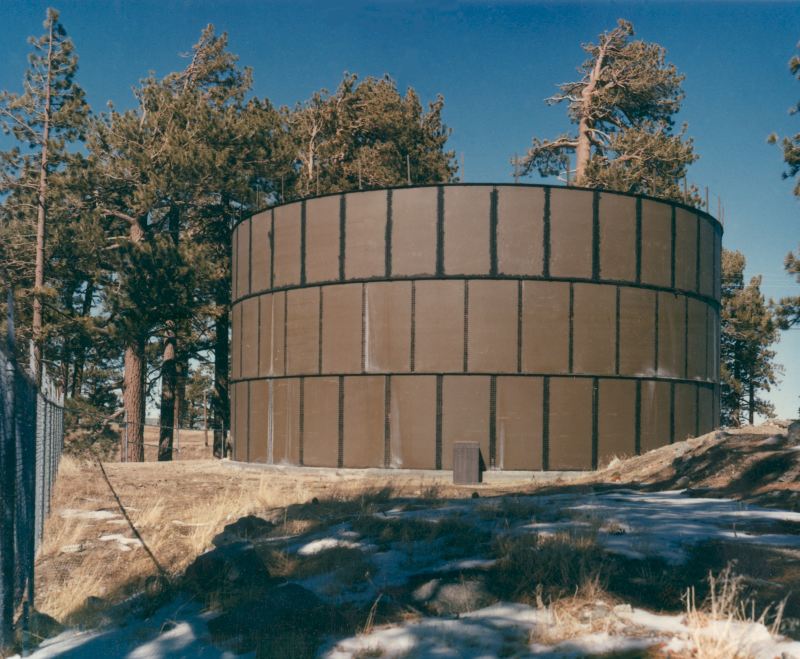
Completed water tank in the Spring of 1965
JPL's Radio Science group, led by Roland Carpenter, also took advantage of this new science
site by having the assistant residence building converted to a laboratory to house equipment
for controlling an 8-foot sub-millimeter wavelength dish mounted on a mobile trailer. There
were a series of tests made to calibrate the dish, and Table Mountain became a new reliable
site for this science. From 1964 through 1965, radio science measurements merited a larger
permanent installation of a new 16-foot dish. Calibrating the 16-footer required a bore site
facility, which after USFS approval, was located at Wright Mountain, with a required minimum
separation of 4 miles. The following images show the dishes, buildings, mounts, and the bore
site facility. For some unusual circumstance, after the necessary calibration of the new dish
was completed, Wright Mountain suffered a major geological slippage where the building bore
site building was located. Earl and the author retrieved all the electronics from the building
after an initial slippage of about 20-feet. The building had partially crumbled within another
year, so the building was destroyed. By the year 200, parts of the remaining building were
no longer visible.
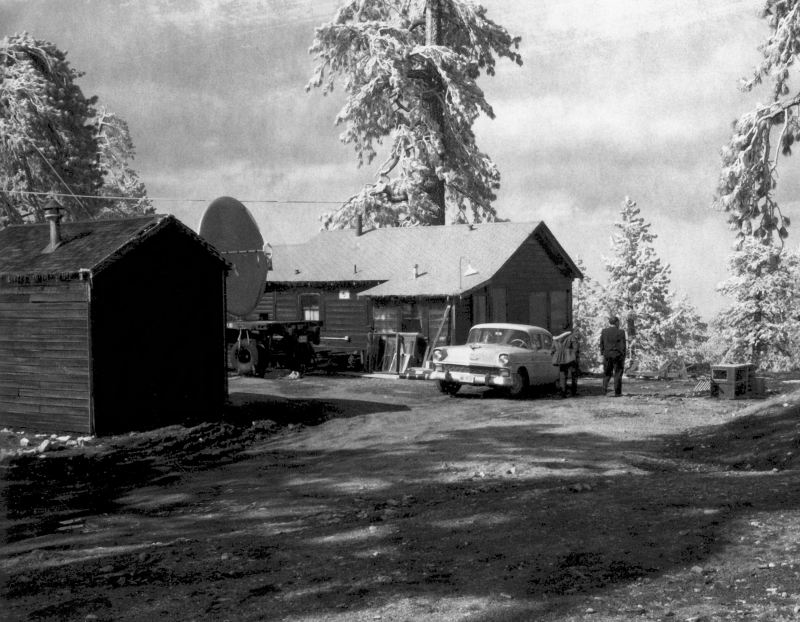
The old Smithsonian assistant director's residence in late 1963
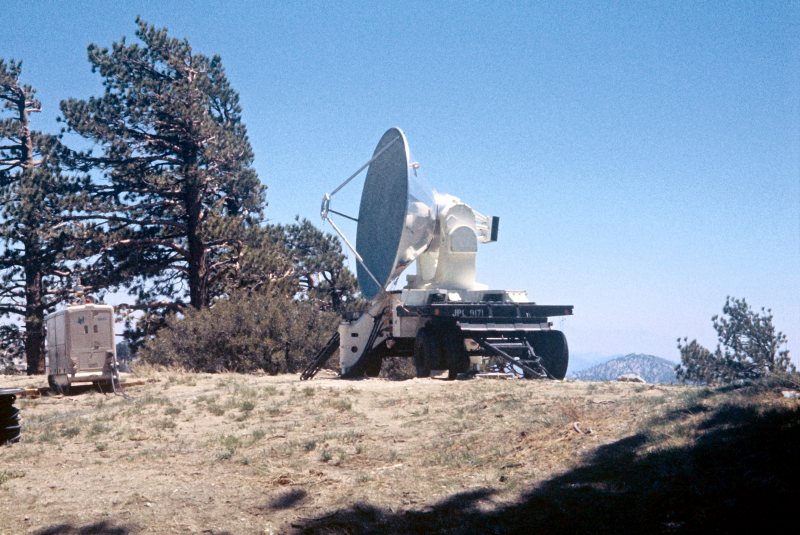
The 8-foot mobile dish set up for use in early 1964
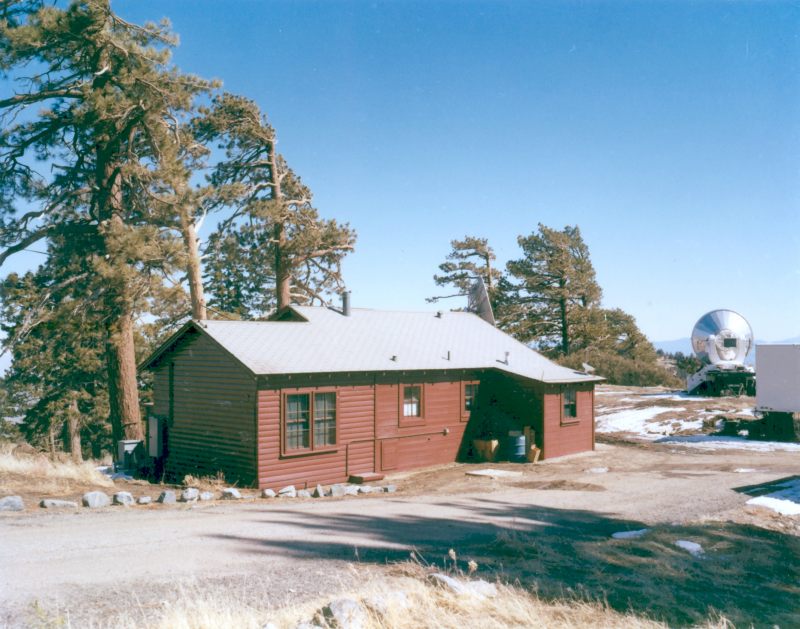
Building (now TM-5) is converted to a radio science laboratory, with the 8-foot dish in the
background, and in operation - 1964
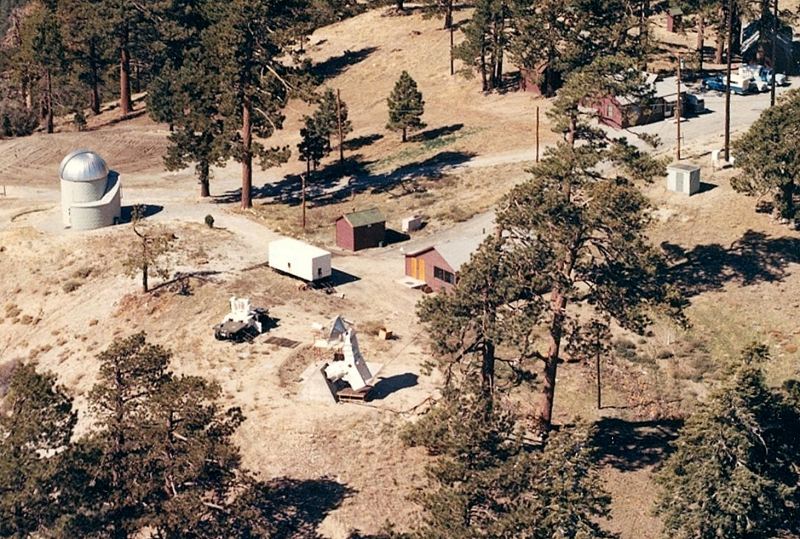
Late in 1965, a new fixed concrete pier houses the 8-foot dish
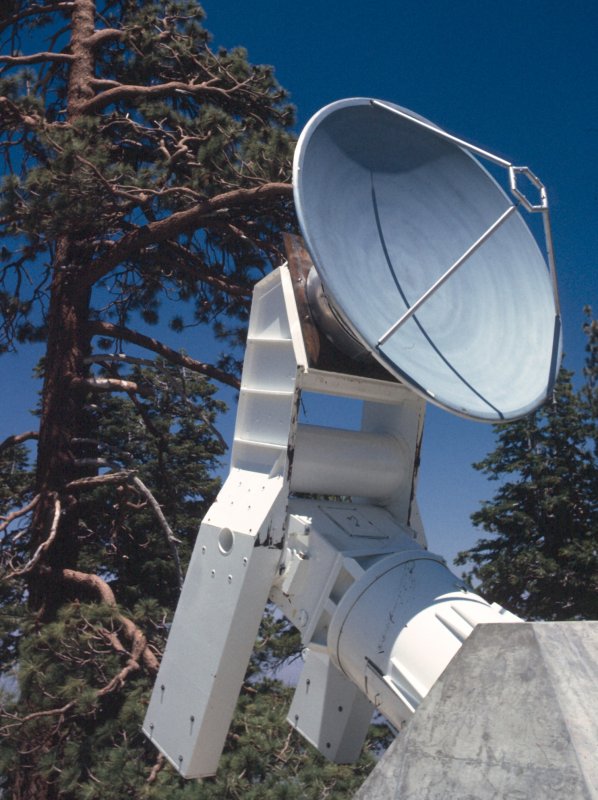
8-Foot Dish on new concrete pier - Early 1966
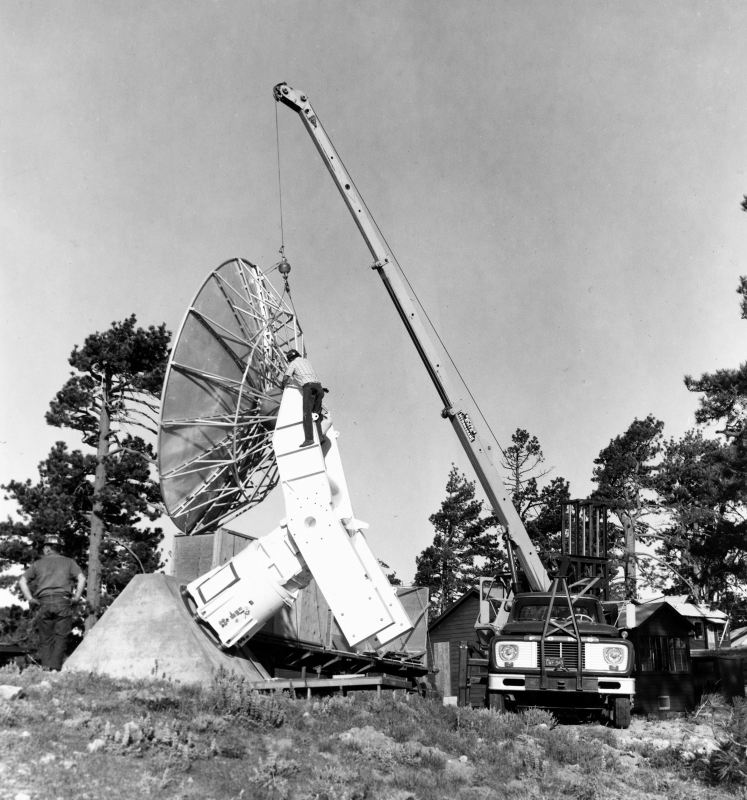
Installing the new 16-foot Radio Science Dish - Summer, 1967
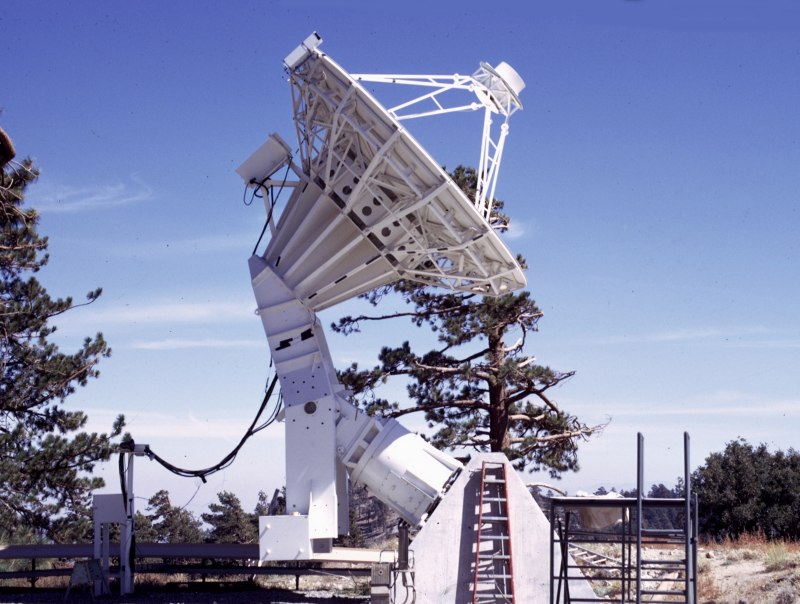
Completed 16-Foot dish in the Fall of 1967
The Wright Mountain Bore Site for JPL's Radio Science Group
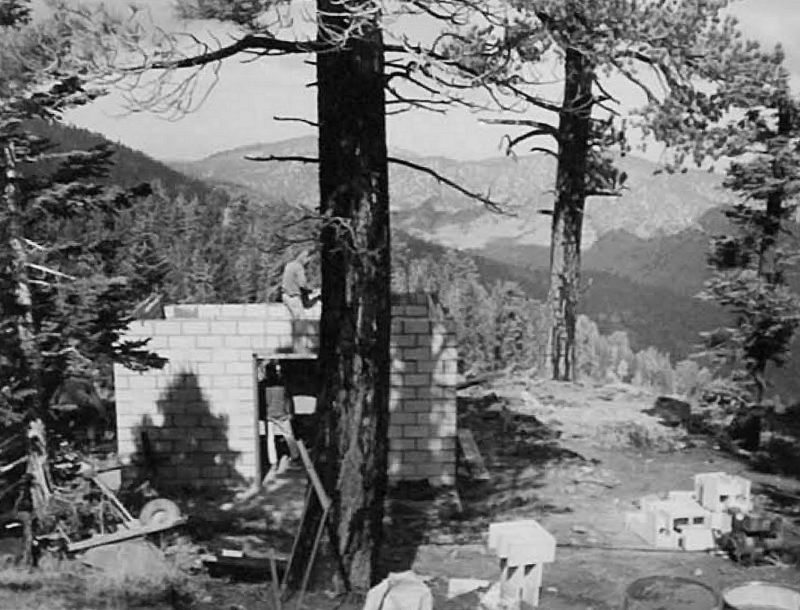
The Bore Site construction in October, 1966
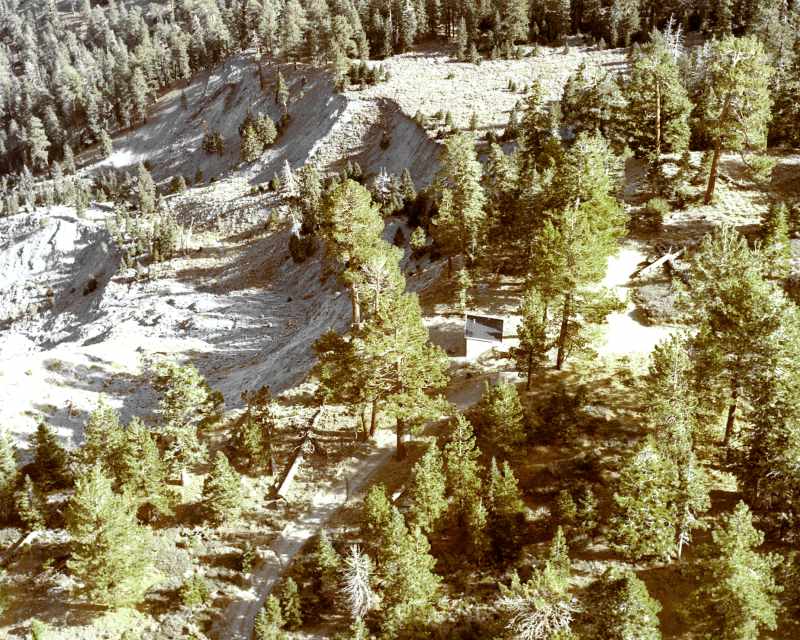
An aerial view of the Bore Site in November, 1966
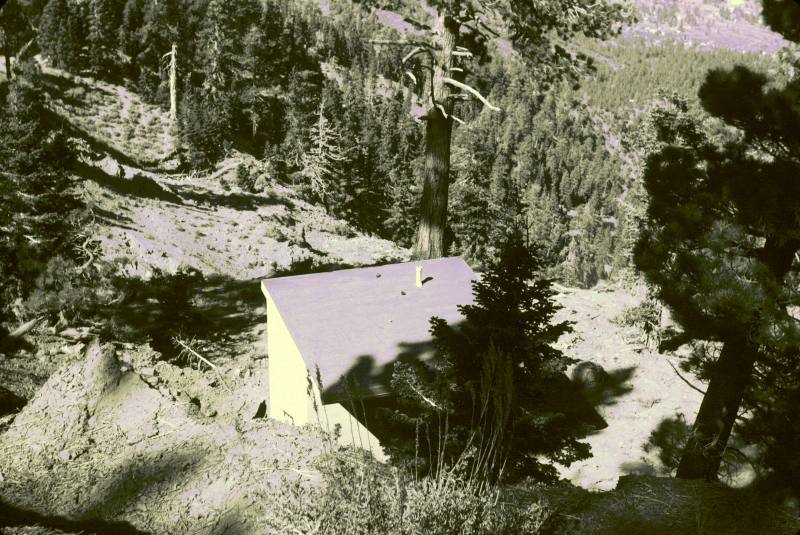
Ivie and the author climbed down to retrieve the electronics and other equipment after the
20 foot slippage after the winter months of 1966-67.
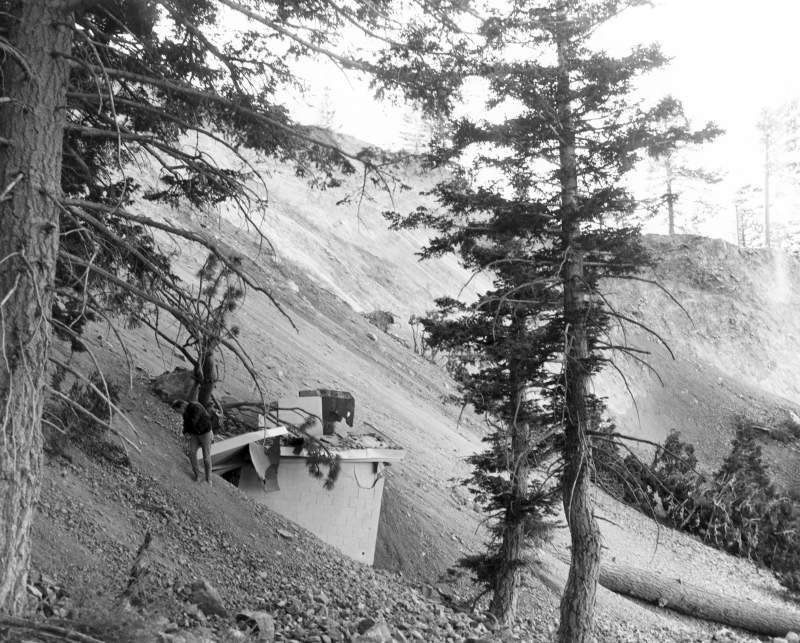
Further slippage of the Bore Site building on November 29, 1967
Despite specific needs of the new optical astronomy telescope observations (dark skies, clean
air, with no external heat waves generated by nearby buildings), JPL's Thermionic's Division
constructed a Butler building just to the west of the 16-inch telescope facility to house their
new solar concentrator and tracker. This new facility opened in late 1963, and replaced the
old mobile solar trailer on site since the early 1960s.
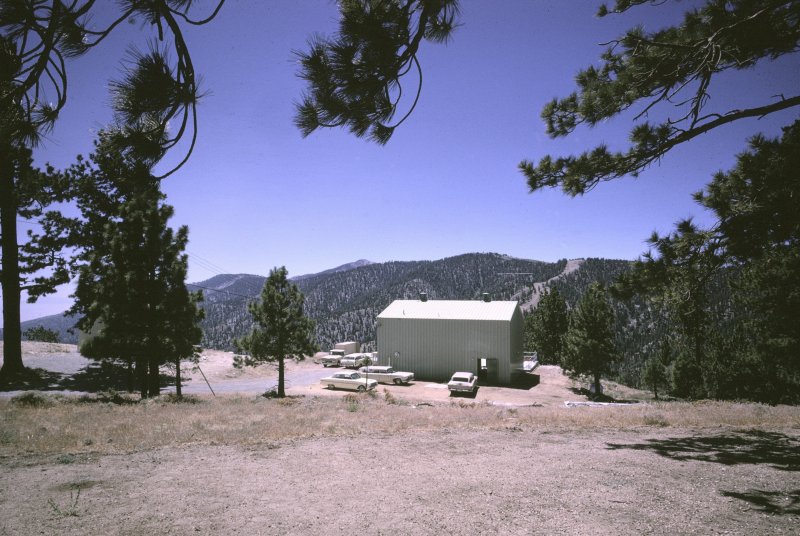
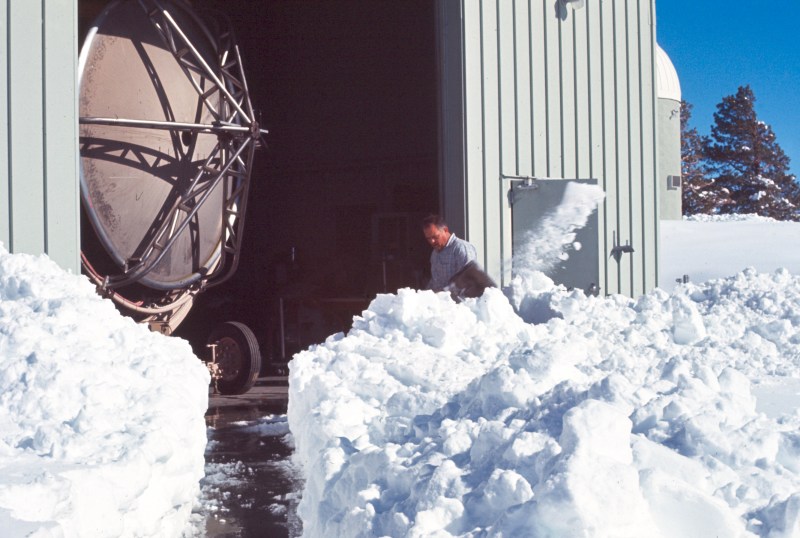
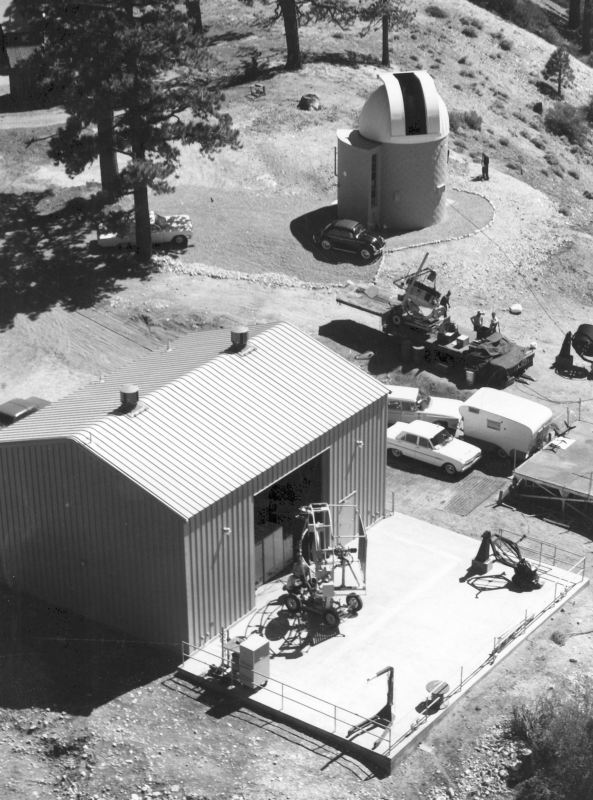
An Aerial view of the thermionics building - 1963
During the winter of 1963-64, Table Mountain had many feet of snowfall. The new Butler
building had internal heat to keep all its electronics at 'room temperature'. This created
a problem for the operations of the 16-inch telescope...the heat waves generated by the
Butler building caused very poor astronomical 'seeing' for the optical astronomy operations.
It was around this time that the two JPL science divisions needed an arbitrator to assess
conflicts, and propose solutions. A Table Mountain 'Steering Committee' was set up at the
end of 1963, especially to resolve this issue between the science and thermionics divisions.
The new committe was composed of Johnny Stephen, Barney Huber, and Jack Tallon. The
first issue they dealt with was to make Capen the 'Site Manager', that gave him authority
to resolve local problems/conflicts...parking, visitors, firearms, alcohol, etc. Negotiations
between the 2 divisions resulted in the thermionics division agreeing to move its operations
to a yet undeveloped site one half mile east of the main Table Mountain operations. A new
road was constructed around the north side of the current site, to the new area about 100
feet lower in elevation. Also, at this time, Capen felt the need to officially number each of
the buildings. With the initial construction of the optical telescope building, the first of all
new JPL buildings, Capen numbered the telescope building as TM-1; the thermionics building
became TM-2 (moved to its new site to the east), the two (combined) bunkers were TM-3,
and so on, as noted in the map below after the new road construction. JPL also built a new
Industrial Users Site, below the top of the mountain to the south. Those many users could
now access their own site at any time with a locked gate. This is shown in the last image.
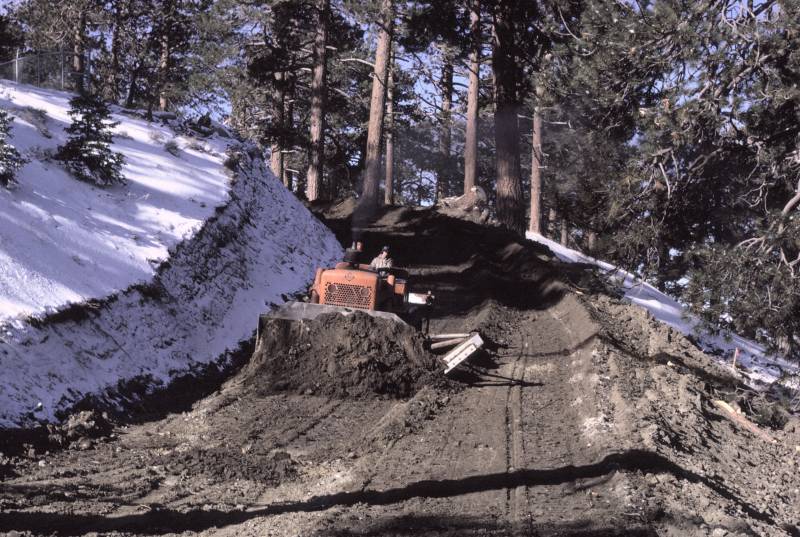
The new road construction for the thermionics building to move to the newer site - 1965
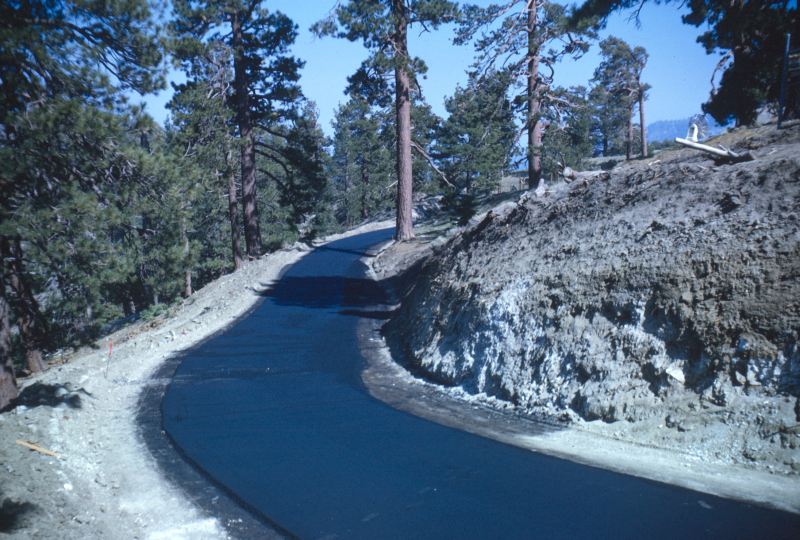
Paveing the new road to the thermionics building in the Spring of 1965
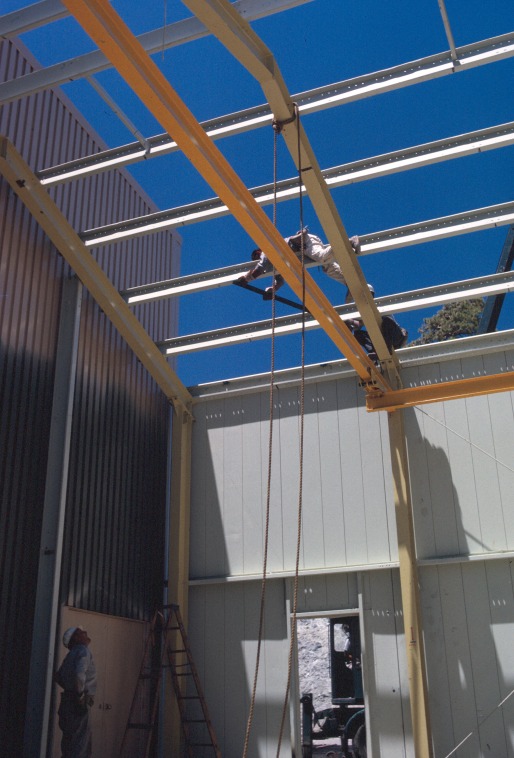
The new addition to the Butler building, listed as TM-14; added to the already
TM-2 - 1965
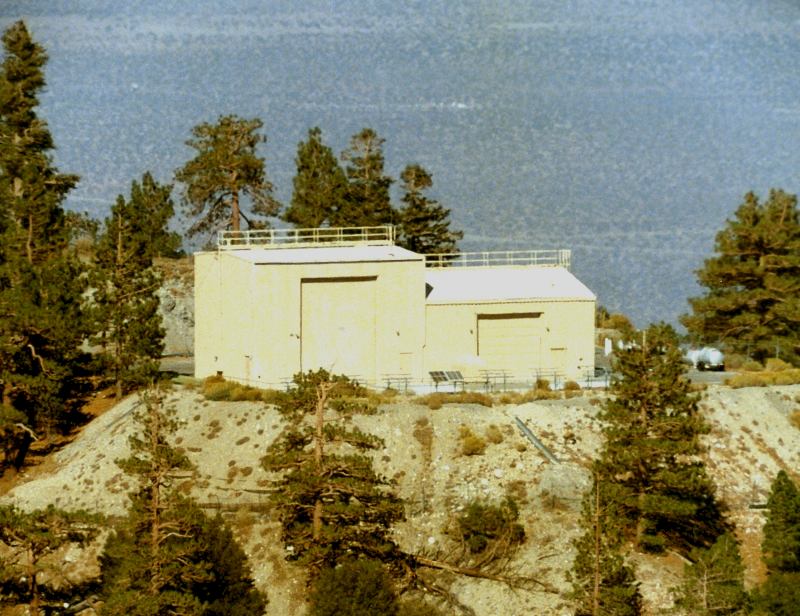
TM-2 and TM-14 combined into one facility in 1966
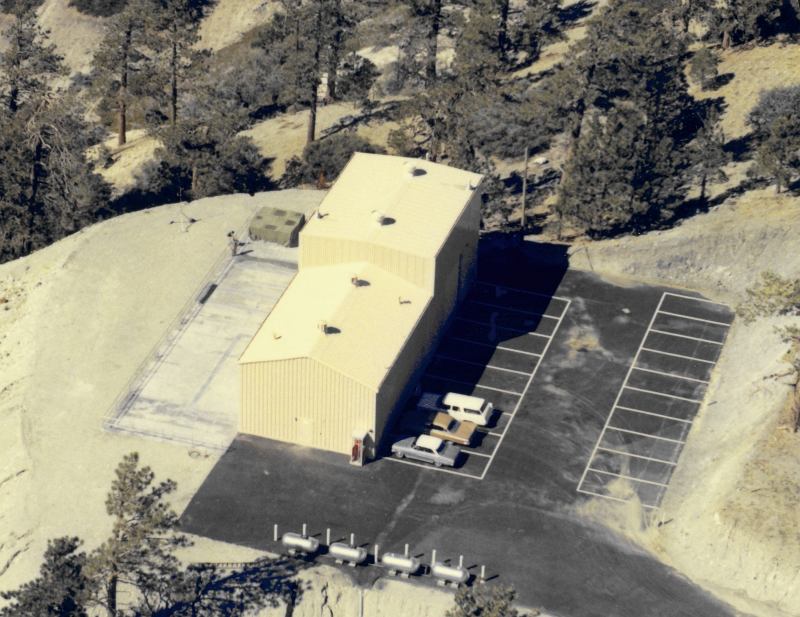
TM-2 and TM-14 with added parking lot - 1968
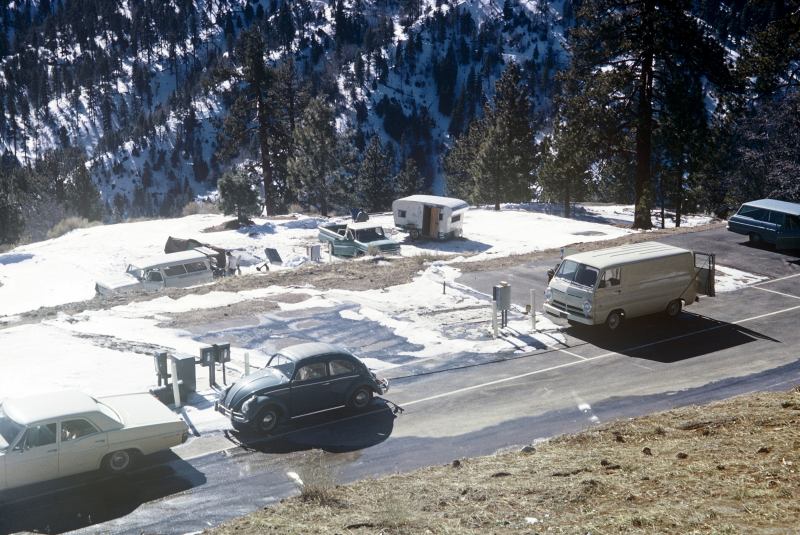
The new Industrial User's Site below the top of Table Mountain - 1965
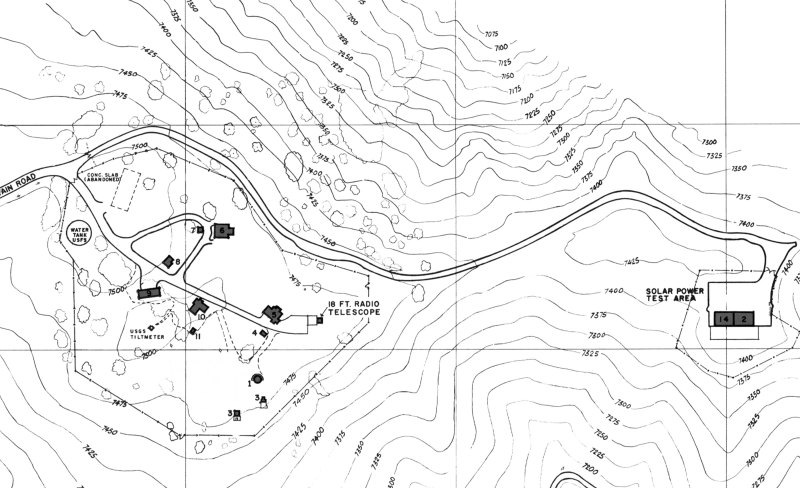
Map of the Table Mountain Site as of late 1965, with the new Thermionics Butler building
seen here well east (right side) of the main site. Notice the numbers of the various other
buildings. When the Butler building was moved east, a new section was added at the same
time, now referred to as TM-14.
The Table Mountain 'Steering Committee' soon realized with new site developments, roads,
and building construction, Capen was being overworked while his main job with the planetary
astronomy program was being seriously impacted by all the day-to-day site issues. It was
decided to hire a full-time 'Site Manager' position. JPL found such a man, Earl Ivie, that
already worked at their facility in Pasadena. He agreed to the new position, and moved his
residence to Wrightwood in early 1965.
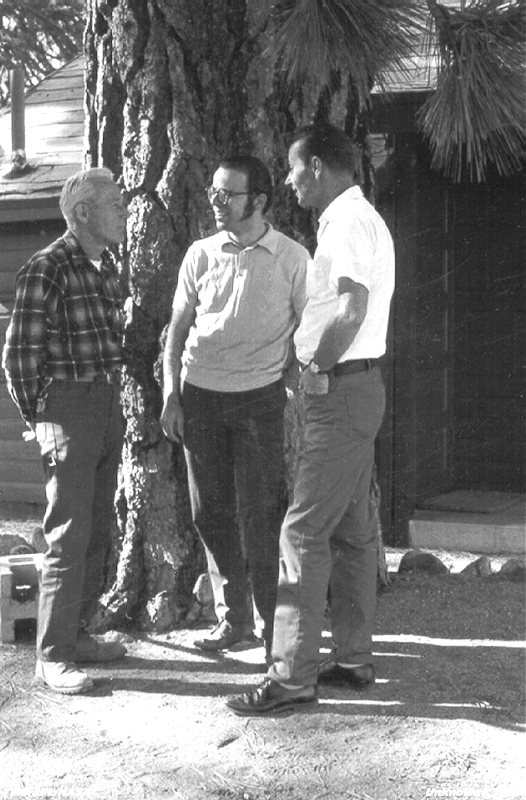
The new Site Manager - Earl Ivie (left), with the author (center), and Jay Dobbs (right)
who was the general contractor JPL inspector for all new construction at Table Mountain.
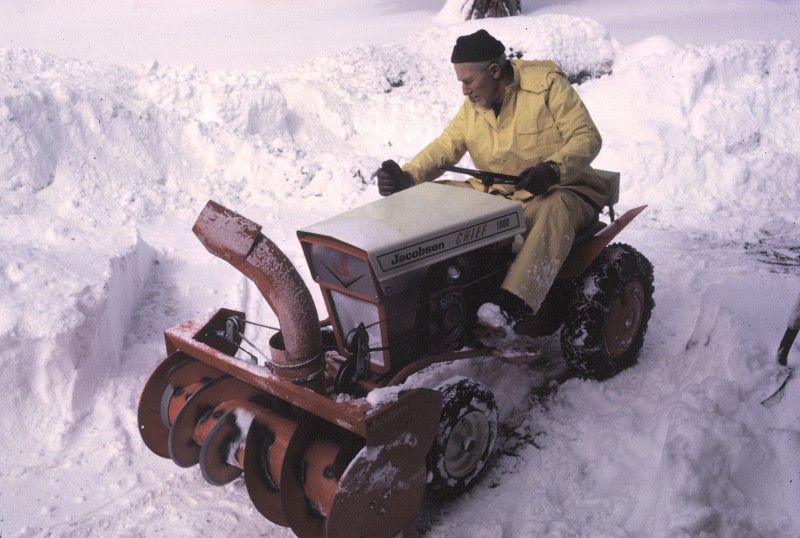
It was obvious Ivie had been an excellent choice. He had experience in so many areas!
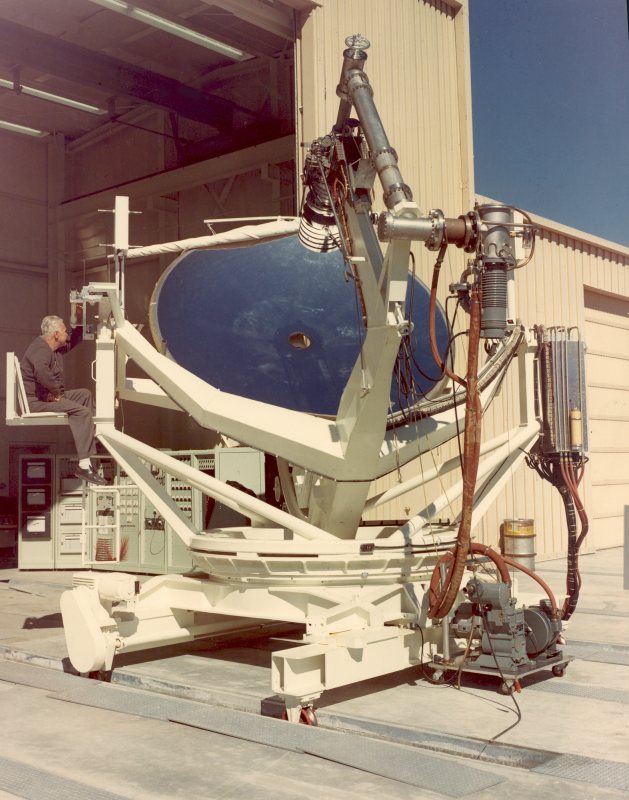
Another example of Ivie's extended experience...running the solar tracker at TM-2/14.
Mr. Ivie then occupied TM-8, the old Smithsonian bunk house, for a new Site Manager's
office. Ivie spruced up the site by have a marigold flower garden planted outide his door.
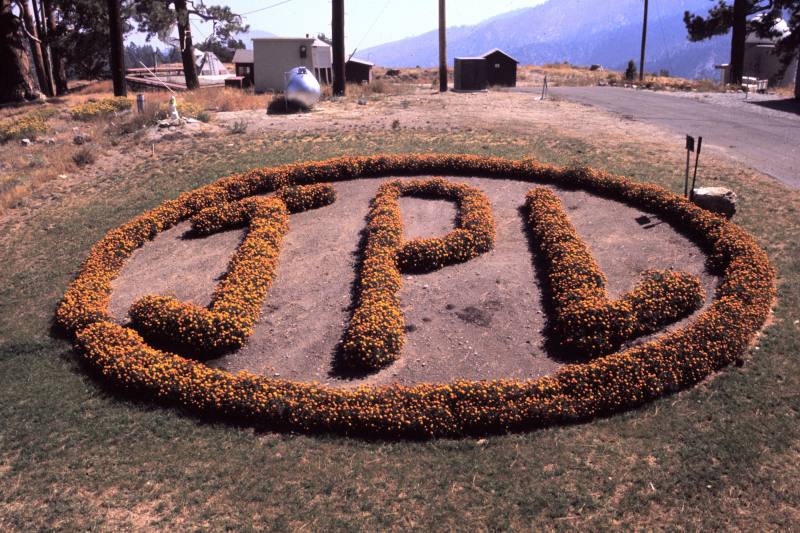
End of Part 4 Part 5